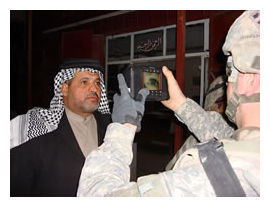
© Computer World
DARPA defines biometrics as "the science and technology of measuring and analyzing biological data." Biometric technology has a trickledown theory, where military technology eventually makes its way into civilian applications. Biometric recognition is not just something from a fictional spy-thriller.
Since 9/11, the government and law enforcement increased the use and collection of biometric identification in the name of security to identify terrorists or criminals. Yet civil liberty advocates worry about the increased use of biometric recognition as well as the storage and management of government databases. However, biometric recognition technologies continue to emerge.
According to
Wikipedia, uniquely identifying a person via biometric characteristics can be physiological like fingerprints, facial recognition, DNA, palm prints, iris or retina recognition, and odor/scents; or behavioral like voice or gait recognition. Biometric technology has been around for a long time, but here's a look at some current and future uses.
Current Biometric NewsBiometrics can be used for access management and control such as a fingerprint swipe to start a computer or for cybersecurity efforts. The Obama administration is pushing for an Internet ID for Americans as part of the National Strategy for Trusted Identities in Cyberspace.
Homeland Security has been
conducting iris scan tests at the U.S. border to track illegal aliens, but that sounds pretty tame compared to India. Last year,
Big Indian Brother started issuing biometric ID Cards with iris scans, fingerprinting and facial recognition photos for 1.2 billion residents.
Recently, a U.S. judge allowed biometric facial recognition evidence to be submitted for the first time in a criminal trial, reported
Homeland Security Newswire. A San Francisco Superior Court judge allowed "still frames from the video footage along with testimony from a biometrics expert who argued that comparisons between current photos and the still frame" proved the suspect was not the shooter.
That was groundbreaking as some experts question the effectiveness of biometric recognition systems. The National Research Council
released a 183-page report stating that biometric recognition has "inevitable uncertainty and risk of errors." Champions of biometrics accused the report of being out-of-date and misleading. Michael DePasquale, CEO of BIO-key International,
told Network World, "Over the last six years, the technology has made significant contributions to not only our national security, but also to protecting access to a wide variety of commercial applications including smartphones, laptops, offices, homes, commercial networks, point-of-sale terminals and medical storage cabinets."
But biometric technology makes privacy violations like surveillance and tracking easier than ever. Unlike a credit card that be canceled if stolen, most people wouldn't go so far as biometric fraud and
replace their fingerprints or irises. The
EFF warns, "Some biometrics, like faces, voices, and fingerprints, are easily 'grabbed.'"
Speaking of easy to get,
Technology Review reported on the prototype AIRprint device, a "biometric sensor that can scan fingerprints from a distance of two meters."
In Iraq and Afghanistan, the U.S. military often uses the small and portable
Handheld Interagency Identity Detection System (HIIDE) a "hand-held tri-biometric system that allows users to enroll and match via any of the three primary biometrics: iris, finger and face." This biometric device is also pointed toward police applications.
There is a new-and-improved version, four biometric tools in one, as recently
announced by Lithuanian-based Neurotechnology.
MegaMatcher 4.0, is a new "multi-biometric software development kit (SDK) that integrates fingerprint, iris, facial and palmprint biometrics in a single, high-performance SDK that requires no add-ons."
Australian pubs and clubs are signing up for biometric databases in order to put an end to bar fighting.
CNET points out the databases have almost no government regulation and biometric databases "are not covered by privacy laws, meaning that the handling of details are left to the discretion of technology vendors." Biometrics in the FutureIf biometrics can be used to catch a killer, very few of us would object. It's a very difficult process for law enforcement to recover fingerprints from fabrics, but
forensics experts at the University of Abertay Dundee are conducting groundbreaking research "to recover fingerprint ridge detail and impressions from fabrics."
In the future, cars will use biological data to decide if its driver is too drunk to drive.
TruTouch Technology secured $2.1 million in additional funding for its biometric solutions to detect alcohol intoxication levels. While some people think this is cool, others have voiced privacy concerns.
According to The Huffington Post, The Driver Alcohol Detection Systems for Safety approach would use automatic sensors to measure blood alcohol content by "either by analyzing a driver's breath or through the skin, using sophisticated touch-based sensors placed strategically on steering wheels and door locks."
Those examples only slightly scratch the surface of using biometrics for security measures.
ComputerWorld Canada reported, "The worldwide biometrics market will increase to US$14 billion by 2015. This increase is because there are growing demands for security against terrorism, sophisticated crimes and financial fraud."
Oh yes, biometric recognition is here to stay. Using biometrics is not all bad or all good, but the social impact on privacy will be huge.
Reader Comments
to our Newsletter